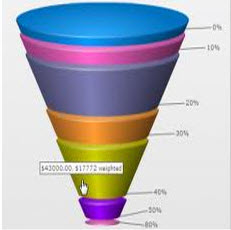In this new digital world marketers have been forced to move beyond the traditional approach to the sales pipeline (awareness, interest, demand, action) and the more moderated approach (awareness, interest, consideration, purchase) which is outdated. The customer is no longer a passive recipient of information or a sidelined spectator. Today, customers are actively engaged in the buying process.
To create engagement and enhance the customer experience, marketers today use a mix of vehicles, including search engines, customer-generated blogs, reviews, online communities, social networks, broadcast media, and personalisation. Therefore, how we approach, define, and use the pipeline must also change.
When developing, implementing, and measuring Marketing’s contribution to the opportunity pipeline, consider the following six revised key measurable stages, which reflect today’s environment: These labels differ from the traditional approach as they are behavioral, which makes it easier to define which behaviors for each measurable stage you want to be able to affect and measure. Together, those steps create the series of behavioral events that many prospects exhibit on their way to becoming and remaining customers.
Let’s examine each stage.
1. Contact
Though awareness is “just fine and dandy,” what really matters is establishing contact. Prospects may be aware of your company and its products and services, but until they demonstrate some degree of interest you may be wasting time and money. Making contact means you need more than a vague idea of the market or customer set; you must have contact information.
2. Connect
Once contact is made, the next thing to do is to connect. What is the difference between a contact and a connection? Contact is an observable signal of ‘hello’ from a customer; A connection is the virtual exchange of a handshake (at least) and the establishment of some type of rapport. Unfortunately, just because you have made the connection doesn’t mean you have a customer.
You want those you’ve connected with to become followers—and download material from your website, sign up for your newsletter, participate in your webinars, etc. That is why the conversation stage is so important.
3. Conversation
Now we’re talking! That’s the best way to describe the conversation stage. Information flows back and forth between prospects/customers and you. Both parties are engaged.
This is the stage where the rubber meets the road and you start to get traction: Once the conversation is in play, the next step is consideration.
4. Consideration
Just because you have a conversation in play with a customer, doesn’t mean you have a qualified opportunity who is seriously considering purchasing from you.
Consideration involves customers’/prospects’ applying careful thought to your offer and company and weighing their options. Different marketing vehicles, such as customer references, case studies, and third-party whitepapers, will be deployed at this stage to help the customer/prospect build preference and predisposition toward your offering.
5. Consumption
Even though the opportunity has now moved to the domain of Sales, Marketing still plays a role in converting the opportunity from consideration to a contract to consume, or an actual consumption of the product or service. And upon consumption, Marketing can measure the overall conversion rate and time, the cost from contact to customer, the cost to acquire, and Marketing’s “win” rate.
6. Community
To stop investing in a relationship that has just begun would be a shame. A customer is your most important asset. Customers are also your most important advocates. In the world of customer-generated content, blogs, social networks, and product reviews, marketing organizations need to focus on developing their customer communities, the final “C” in the pipeline.
You can build a community in numerous ways, including Facebook, LinkedIn, and other social networks that provide a means for your customers to engage with you and one another.


